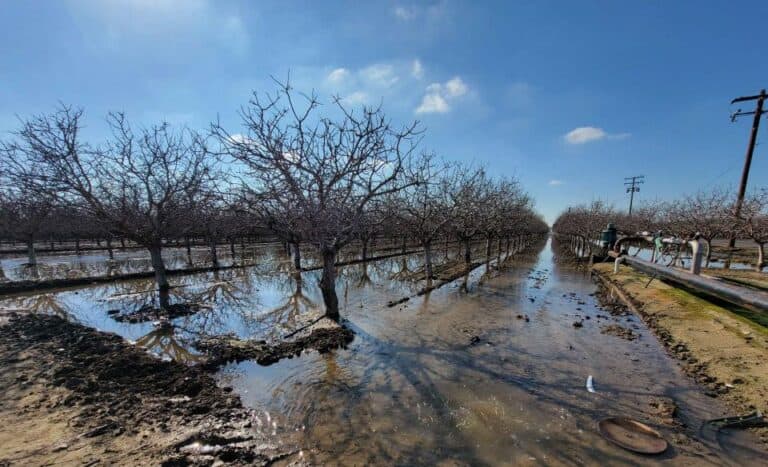WESTERN WATER IN-DEPTH: January storms jump-started recharge projects in badly overdrafted San Joaquin Valley, but hurdles with state permits and infrastructure hindered some efforts
Photo: Farmers and water agencies capitalized on January’s storms by intentionally flooding land to spur aquifer recharge, like at this Tulare County almond orchard. (Source: Aaron Fukuda/Tulare Irrigation District)
It was exactly the sort of deluge California groundwater agencies have been counting on to replenish their overworked aquifers.
The start of 2023 brought a parade of torrential Pacific storms to bone dry California. Snow piled up across the Sierra Nevada at a near-record pace while runoff from the foothills gushed into the Central Valley, swelling rivers over their banks and filling seasonal creeks for the first time in half a decade.
Suddenly, water managers and farmers toiling in one of the state’s most groundwater-depleted regions had an opportunity to capture stormwater and bank it underground. Enterprising agencies diverted water from rushing rivers and creeks into manmade recharge basins or intentionally flooded orchards and farmland. Others snagged temporary permits from the state to pull from streams they ordinarily couldn’t touch.
Yet not everyone was able to fully capitalize on Mother Nature’s gift.
Drowning land with floodwater to repay groundwater debts requires agencies to navigate a state permitting system that isn’t nimble enough to adapt to sudden changes in weather. Agencies must file complex, costly plans months ahead of California’s notoriously fickle rainy season, a guessing game some didn’t bother with given the likelihood of another dry La Niña winter. And, in some cases, inadequate infrastructure prevented agencies from spreading water to where it was needed while other recharge projects just haven’t moved along fast enough to gulp the deluge.
The barrage of water was in many ways the first real test of groundwater sustainability agencies’ plans to bring their basins into balance, as required by California’s landmark Sustainable Groundwater Management Act (SGMA). The run of storms revealed an assortment of bright spots and hurdles the state must overcome to fully take advantage of the bounty brought by […]
Full article: California Water Agencies Hoped A Deluge Would Recharge Their Aquifers. But When It Came, Some Couldn’t Use It

